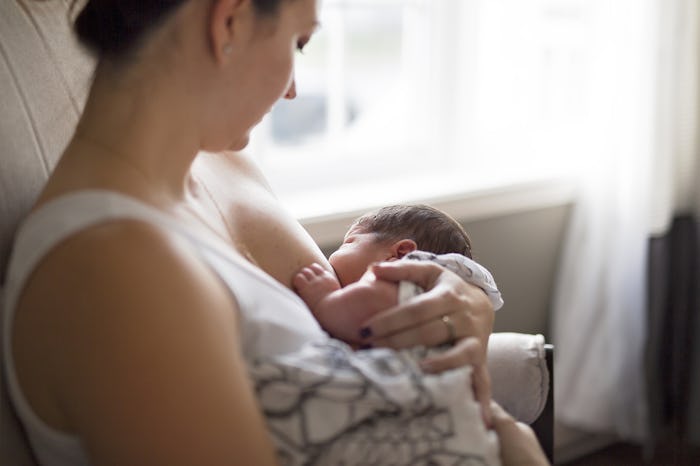As a mom who breastfed two children for their first 18 months of life, I can tell you that the process often gets off to a rocky start. I've experienced my fair share of sore nipples and practically lived with a tub of shea butter on my nightstand. But once I learned how to set them up for a successful latch, it was smooth sailing until they discovered that peas and apples tasted much better. If you're preparing to nurse your newborn, you should understand how to know if baby is latching correctly so breastfeeding doesn't end up causing you more pain than pleasure.
In the first days and weeks of breastfeeding, you and your baby may experience some growing pains as you work to find your nursing groove. Since only one of you has the ability to talk, you'll have to rely on lots of nonverbal cues to let you know that things are going well and they're getting enough milk. Fortunately, there are plenty of signs to watch for in your baby and your own breasts that will indicate that they're in the best position to fill up on your breast milk.
When your baby is on your breast, the movement of their lips, jaws, and ears can let you know that everything is working properly. And when they're done, your nipples should not look or feel like they've been run over by a car. It may take a little practice, but eventually the right latch will be like second nature to your little one. And you'll be able to enjoy that special mommy-baby time without pain.
1Their Lips Are Visible
Your baby's lips should be turned out rather than pulled in when he's nursing effectively. According to Dr. Sears' website, seeing the pink of your baby's lips while they nurse means they have a good latch and won't put unnecessary strain on your nipples.
2Their Ears Are Wiggling
As Dr. Sears' website mentioned, your baby's wiggling ears are another sign of a good latch, and an indication that your baby is enjoying a hearty meal. As your milk flows, the act of sucking and swallowing will cause her ears to move.
3Their Cheeks Are Rounded
Your little chipmunk doesn't have to worry about storing food in their cheeks for later, but during some of your nursing sessions, you may think that's just what tjey're doing. According to the American Pregnancy Association, if baby's cheeks are rounded, you will know that he's latching correctly.
4You Will Hear Swallowing
When your baby has a good latch, the sucking will cause your milk to flow. Chances are, you will hear your baby gulping down all of that sweet milk, as the American Pregnancy Association mentioned.
5You Can See Their Tongue
If you're having trouble determining whether or not your baby has a good latch, try gently pulling down their bottom lip to check for on their tongue. If a baby is latched correctly, you should be able to see the baby's tongue between your breast and their gum, according to La Leche League International.
6You'll Feel Their Chin
In order to make sure your baby has the best chance of getting a good latch, you'll want to make sure he's as close to the breast as possible. According to La Leche League International, if your baby is latched correctly, you should feel your baby's chin against your breast. If you can't feel his chin or nose, it is possible that they don't have enough of your breast in their mouth.
7Your Nipple Is Not Flat
One of the easiest ways to know your baby is latched incorrectly is that nursing takes its toll on your nipples. Flat, misshapen nipples are an indicator that your baby is not latched properly, as the American Pregnancy Association noted,
8They'll Seem Satisfied
When your baby has had enough to eat, you will know it. Some of the signs your baby has had a good meal include looking relaxed, removing herself from the breast, and falling asleep, according to the American Pregnancy Association.
